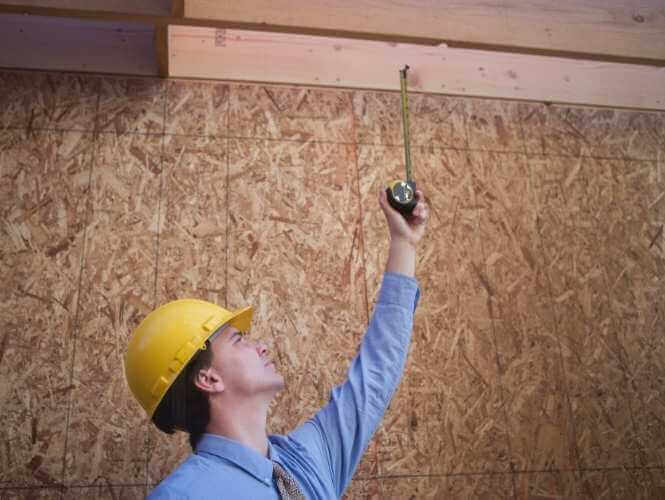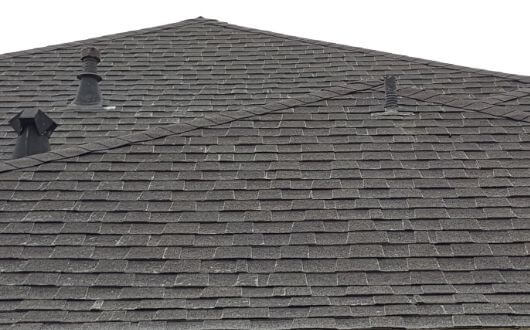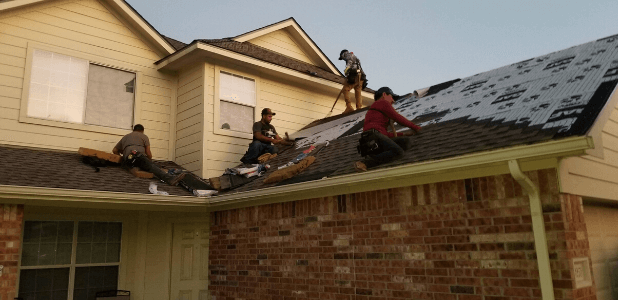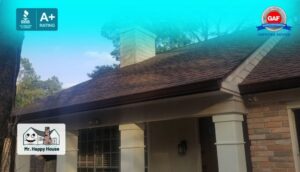
Best GAF Certified Roofers in The Woodlands, TX – Quality Roof Replacement, Gutters & Siding
Best GAF Certified Roofers in The Woodlands, TX – Quality Roof Replacement, Gutters & Siding Best GAF Certified Roofers in The Woodlands, TX – Quality

Residential roof damage can be a homeowner’s worst nightmare, whether it’s caused by severe weather, aging, or other factors. Addressing roof damage promptly and effectively is crucial to maintaining the overall integrity of your home and preventing further problems down the line.
In this guide, we’ll explore the steps and considerations involved in how to address residential roof damage, from initial assessment to repair and maintenance strategies.

Before you can effectively address residential roof damage, it’s essential to conduct a thorough assessment and inspection of your roof. This initial step will help you understand the extent of the damage and determine the best course of action. Here’s a detailed breakdown of how to approach the roof assessment and inspection process:
– Schedule a Safe Time: Choose a clear day when the weather is dry to inspect your roof. Safety should be your top priority, so avoid conducting inspections during adverse weather conditions or when the roof surface is wet and slippery.
– Gather Necessary Tools: Equip yourself with the appropriate tools for the inspection, including a sturdy ladder, safety harness or harness anchor, flashlight, binoculars, and a notebook or smartphone to document your findings.
– Exterior Inspection: Begin by visually inspecting the exterior of your roof from ground level. Look for obvious signs of damage such as missing or damaged shingles, sagging areas, or visible debris.
– Interior Inspection: Next, inspect the interior of your home, paying close attention to the ceilings, walls, and attic spaces directly beneath the roof. Look for signs of water stains, mold or mildew growth, and any other indications of water intrusion.
– Check for Leaks: During your inspection, be vigilant in checking for signs of leaks or water damage. These may manifest as discolored patches on ceilings or walls, damp spots in the attic, or musty odors indicative of mold or mildew growth.
– Inspect Flashing and Seals: Pay special attention to areas where the roof meets other surfaces, such as chimneys, vents, skylights, and dormers. Check the condition of flashing, seals, and caulking around these penetrations, as they are common areas for water infiltration.
– Document Findings: As you conduct your inspection, take detailed notes and photographs of any damage or areas of concern. This documentation will be valuable when communicating with roofing contractors or insurance providers.
– Consider Hiring a Roofing Professional: If you’re unsure about the extent of the damage or don’t feel comfortable conducting the inspection yourself, consider hiring a professional roofing contractor to assess your roof. They have the expertise and experience to identify hidden issues and provide reliable recommendations for repair or replacement.
By thoroughly assessing and inspecting your residential roof, you’ll gain valuable insights into the condition of your roof and be better equipped to take appropriate action to address any damage or issues that may arise.

Identifying the specific types of damage to your residential roof is crucial for determining the appropriate course of action. Different types of damage may require different roof repair techniques and roofing materials. Here are some common types of roof damage to look out for:
– Leaks: Roof leaks are one of the most common types of damage and can result from various issues such as missing or damaged shingles, deteriorated flashing, or cracked seals around vents or chimneys. Signs of a roof leak may include water stains on ceilings or walls, damp spots in the attic, or visible water dripping during rain.
– Shingle Damage: Missing, cracked, or curled shingles can compromise the integrity of your roof and leave it vulnerable to more leaks and further damage. Inspect your roof regularly for signs of shingle damage, such as discolored patches, granule loss, or pieces of shingle debris in gutters or on the ground.
– Roof Flashing Issues: Flashing is the metal or other material installed around vulnerable roofing areas such as chimneys, vents, and skylights to prevent water intrusion. Damaged or improperly installed flashing can lead to leaks and water damage. Check for signs of rust, corrosion, or gaps in flashing seals.
– Structural Damage: Damage to the underlying structure of the roof, such as sagging areas or rotting wood, can compromise the stability and safety of your roof. Look for signs of sagging or uneven areas on the roof surface, as well as any signs of water damage or rot in attic rafters or trusses.
Identifying the specific type of damage to your roof will help you determine the best course of action for addressing it. In some cases, minor damage may be repairable with DIY techniques, while more severe damage may require professional intervention or even roof replacement.
In addition to visually inspecting your roof for signs of damage, it’s also important to be aware of any recent severe weather events or other factors that may have contributed to roof damage. High winds, hail, heavy rain, and falling debris can all cause significant damage to residential roofs.
If you suspect that your roof may have been damaged by severe weather, it’s advisable to have it inspected by a professional roofer to assess the extent of the damage and perhaps file a roof insurance claim.

When faced with residential roof damage, it’s essential to take immediate action to prevent further harm to your home. While a permanent solution may require professional assistance or more extensive repairs, temporary fixes can help mitigate the damage and provide temporary relief. Here are some temporary fixes and damage mitigation strategies to consider:
Damage Mitigation Strategies:
– Interior Protection: Place buckets or containers to catch dripping water from ceiling leaks. Use towels or rags to soak up excess water and prevent it from spreading to other areas of your home.
– Clearing Debris: Remove any debris or branches from your roof to prevent further damage or blockage of drainage systems. Use caution and appropriate safety equipment when accessing your roof.
– Gutter Maintenance: Ensure that gutters and downspouts are clear of debris to allow proper drainage of rainwater. Clogged gutters can lead to water backup and potential damage to your roof and home’s foundation.
-Trimming Overhanging Branches: Trim back any overhanging tree branches that may pose a risk of falling onto your roof during storms or high winds. This can help prevent damage from falling branches and reduce the risk of future roof damage.
-Monitoring Weather Conditions: Stay informed about upcoming weather forecasts and take proactive measures to protect your roof during severe weather events. Secure loose items in your yard, such as patio furniture or outdoor equipment, to prevent them from becoming projectiles that could damage your roof.
Temporary fixes and damage mitigation strategies are crucial steps in addressing residential roof damage promptly and effectively. By taking immediate action to mitigate the damage and protect your home from further harm, you can buy valuable time until permanent repairs can be made.
However, it’s essential to remember that temporary fixes are just that – temporary. For a long-term solution and to ensure the safety and integrity of your roof, it’s recommended to consult with a professional roofer to assess the damage and determine the best course of action.

When faced with residential roof damage, one of the first decisions you’ll need to make is whether to tackle the repairs yourself or seek professional assistance. Each option has its own set of advantages and considerations, and making the right choice depends on factors such as the extent of the damage, your level of expertise, safety concerns, and budget constraints.
Factors to Consider:
-Extent of Damage: Assess the severity and complexity of the damage. Minor issues such as a few missing shingles or small leaks may be manageable for DIY repair, while significant damage or structural issues may require professional expertise.
-Safety: Working on a roof can be inherently risky, especially for those without experience or proper safety equipment. Consider whether you have the necessary skills and precautions to work safely at heights.
-Skill Level: Be honest about your own capabilities. DIY roof repairs require a certain level of skill and knowledge, including basic roofing techniques and the ability to work with tools and materials safely.
-Time and Resources: DIY repairs may save money upfront, but they require a significant investment of time and effort. Consider whether you have the time, energy, and resources to complete the repairs effectively.
-Cost: Compare the cost of DIY roof repairs with hiring a professional roofer. While DIY may seem cheaper initially, mistakes or incomplete repairs could end up costing more in the long run if they lead to further damage or the need for professional intervention.
Pros:
– Cost Savings: DIY repairs can be more cost-effective, as you’re not paying for labor costs.
– Control: You have full control over the repair process and can customize solutions to fit your needs.
– Learning Experience: DIY repairs provide an opportunity to learn new skills and gain a better understanding of your home’s roofing system.
Cons:
– Safety Risks: Working at heights carries inherent safety risks, and DIY repairs may increase the likelihood of accidents or injuries.
– Lack of Expertise: Without proper training and experience, DIY repairs may be less effective or even cause further damage to your roof.
– Time and Effort: DIY repairs can be time-consuming and physically demanding, especially for larger or more complex projects.
Pros:
– Expertise: Professional roofers have the training, experience, and specialized equipment needed to perform repairs safely and effectively.
– Time Savings: Hiring a professional can save you time and effort, allowing you to focus on other priorities.
– Warranty Coverage: Many professional roofing companies offer warranties on their workmanship, providing added peace of mind.
Cons:
– Cost: Professional repairs can be more expensive than DIY, as you’re paying for labor and expertise.
– Dependence on Others: You’ll need to coordinate with the roofing contractor and may need to wait for an available appointment, which could delay repairs.
Ultimately, the decision to tackle roof repairs yourself or hire a professional depends on your individual circumstances and preferences. While DIY repairs can maybe money if you have roofing knowledge and provide a sense of accomplishment, they’re not suitable for most homeowners, especially for complex or extensive damage.
If safety, expertise, or time constraints are a concern, investing in professional roof repair is likely the best option to ensure the integrity and longevity of your home’s roofing system.
Repairing roof damage requires careful attention to detail and adherence to safety precautions. Depending on the extent and type of damage, you may need to undertake different repair methods. Here’s a detailed look at the steps involved in repairing various types of roof damage:
-Assess the Damage: Before beginning any roof repairs, thoroughly assess the extent of the damage. Inspect the affected area both from the inside of your home and from the roof itself. Look for signs of water damage, missing or damaged shingles, deteriorated flashing, and any structural issues.
-Gather Materials and Tools: Once you’ve identified the type of damage, gather the necessary materials and tools for the repair job. This might include roof replacement shingles, roofing nails, roofing cement, flashing material, a hammer, ladder, and other equipment.
-Safety First: Before climbing onto your roof, prioritize safety. Wear appropriate footwear with good traction, use a sturdy ladder, and consider using a safety harness or rope if working on steep roofs. Avoid working on the roof during adverse weather conditions such as rain, wind, or extreme heat.
-Fixing Leaks: Leaks are often caused by damaged or deteriorated flashing around chimneys, vents, or skylights. Remove the old flashing and replace it with new flashing material, ensuring a tight seal around the edges.
-Addressing Structural Damage: Structural damage to your roof, such as sagging or rotted rafters, is going to require professional assistance. A good roofing contractor like Mr. Happy House is experienced in these types of repairs and this is part of the entire residential roofing system.
-Sealing Roof Penetrations: Check for any roof penetrations such as vents, pipes, or satellite dish mounts that may be contributing to leaks.
-Inspect and Test: Once repairs are complete, thoroughly inspect the repaired area to ensure all damage has been addressed. Test for leaks by spraying water onto the repaired area from a hose and checking for any signs of water infiltration inside your home.
By following these steps and taking appropriate safety precautions, you can effectively repair roof damage and protect your home from further harm. If you’re unsure about the extent of the damage or uncomfortable with performing repairs yourself, don’t hesitate to seek professional assistance from a qualified roofing contractor.
Preventive maintenance plays a critical role in preserving the integrity of your roof and preventing future damage. By implementing regular roof and gutter maintenance tasks, you can identify potential issues early and address them before a small roof leak could escalate into something larger. As a homeowner looking to preserve and maintain your roof, you should do:
-Regular Inspections: Conducting regular inspections of your roof is essential for identifying any signs of damage or deterioration. Inspect the roof at least twice a year, ideally in the spring and fall, and after severe weather events such as storms or heavy winds. Look for missing or damaged shingles, cracked caulking around flashing, signs of water damage or leaks, and any sagging or uneven areas.
-Gutter Cleaning: Clogged gutters can lead to water backup and damage to your roof and home’s foundation. Clean your gutters at least twice a year, removing leaves, debris, and any obstructions that could impede water flow. Consider installing gutter guards to help prevent debris buildup and minimize maintenance.
-Trimming Overhanging Branches: Trees near your home can pose a risk to your roof, especially during storms or high winds. Trim back overhanging branches to prevent them from rubbing against the roof or causing damage if they were to fall. This will also help reduce the accumulation of leaves and debris on your roof.
-Check for Moss and Mold: Moss, algae, and mold growth can compromise the integrity of your roof and lead to water damage if left unchecked. Remove any moss or algae growth using a soft-bristle brush or a moss removal solution. Additionally, ensure adequate ventilation in your attic to prevent moisture buildup, which can contribute to mold growth.
-Inspect Flashing and Seals: Flashing around chimneys, vents, skylights, and other roof penetrations is susceptible to damage and deterioration over time. Inspect flashing regularly for signs of rust, corrosion, or loose seals, and repair or replace any damaged flashing promptly. Similarly, check the seals around vents and other roof penetrations for signs of cracking or deterioration.
-Addressing Attic Issues: A well-ventilated attic helps regulate temperature and moisture levels, which can extend the lifespan of your roof. Ensure your attic is properly ventilated to prevent moisture buildup and heat retention, which can lead to premature roof deterioration. Insulate your attic to maintain a consistent temperature and reduce the risk of ice dams forming on your roof during the winter months.
By incorporating these preventive roofing maintenance tasks into your routine, you can protect your roof from damage and prolong its lifespan. Regular inspections and maintenance not only save you money on costly roof repairs but also ensure the safety and integrity of your home for years to come.

Dealing with insurance companies can be a daunting task, especially when it comes to filing claims for residential roof damage. However, understanding the insurance process and knowing what to expect can help alleviate some of the stress. Here’s a detailed breakdown of insurance considerations when addressing roof damage:
-Review Your Policy: The first step in dealing with insurance claims for roof damage is to review your homeowner’s insurance policy thoroughly. Understand what is covered, the extent of coverage, and any limitations or exclusions that may apply to roof damage.
-Document the Damage: Before contacting your insurance provider, document the damage to your roof thoroughly. Take clear photos or videos from multiple angles, highlighting the affected areas. This documentation will serve as evidence to support your claim.
-Contact Your Insurance Company: Once you’ve assessed the damage and gathered documentation, contact your insurance company to initiate the claims process. Provide them with all relevant information, including the date of the damage, the cause (if known), and the extent of the damage.
-Schedule an Inspection: Your insurance company will likely schedule an inspection of your roof to assess the damage and determine the extent of coverage. Be present during the inspection to point out specific areas of concern and ensure that all damage is documented accurately.
-Obtain Estimates: It’s a good idea to obtain estimates from reputable roofing contractors for the cost of repairs or replacement. Provide these estimates to your insurance adjuster to ensure that you receive fair compensation for the damage.
-Understand Your Coverage: Familiarize yourself with your insurance coverage, including deductibles, coverage limits, and any applicable endorsements or riders. Make sure you understand what costs will be covered by your insurance policy and what you may be responsible for out of pocket.
-Follow Up: Throughout the claims process, stay in communication with your insurance company and follow up as needed. Keep detailed records of all correspondence, including emails, phone calls, and letters.
-Appeal if Necessary: If your insurance company denies your claim or offers an insufficient settlement, you have the right to appeal their decision. Review your policy carefully and consider seeking assistance from a public adjuster or legal counsel if needed.
-Be Patient: Dealing with insurance claims can be a lengthy process, so patience is key. Stay organized, keep thorough records, and follow up regularly to ensure that your claim is processed in a timely manner.
-Stay Informed: Keep yourself informed about changes to your insurance policy, state regulations, and any updates regarding your claim. Stay proactive and advocate for yourself to ensure that you receive the compensation you’re entitled to under your policy.
By understanding the insurance considerations involved in addressing residential roof damage and following these steps, you can navigate the claims process more effectively and secure the coverage you need to repair or replace your damaged roof.
Addressing residential roof damage isn’t always about quick fixes; sometimes, it involves considering long-term solutions and upgrades to ensure the longevity and durability of your roof.
Whether your roof has experienced extensive damage or it’s simply reaching the end of its lifespan, investing in long-term solutions can save you time, money, and hassle in the future. Here’s a detailed look at the options available:
-Roof Replacement: If your roof is severely damaged or nearing the end of its lifespan, replacing the entire roof may be the most practical solution. Roof replacement involves removing the existing roof materials down to the decking and installing a new roof system. This option provides a fresh start and allows you to choose from a wide range of roofing materials and styles to suit your preferences and budget.
-Improving Roof Ventilation: Proper attic ventilation is essential for maintaining a healthy and functional roof system. Inadequate ventilation can lead to moisture buildup, which can cause damage to the roof structure and insulation. Upgrading your roof ventilation system can improve airflow, reduce energy costs, and extend the lifespan of your roof.
-Enhancing Roof Insulation: Proper insulation is essential for maintaining a comfortable indoor environment and preventing energy loss. Adding or upgrading insulation in your roof can improve energy efficiency, reduce heating and cooling costs, and enhance overall comfort levels in your home.
Investing in long-term solutions and upgrades for your residential roof can provide peace of mind knowing that your home is well-protected and energy-efficient for years to come. Whether you opt for a complete roof replacement, upgrade to more durable materials, or improve ventilation and insulation, taking proactive steps to enhance your roof’s performance will ultimately benefit both your home and your wallet in the long run.
Learning how to address residential roof damage requires a proactive approach and careful consideration of various factors, including the extent of the damage, available resources, and long-term goals for your home.
By following the steps outlined in this guide and seeking professional assistance when needed, you can effectively address roof damage, protect your home, and ensure the safety and comfort of your family.
Our Services:












Schedule an Estimate Today!

Best GAF Certified Roofers in The Woodlands, TX – Quality Roof Replacement, Gutters & Siding
Best GAF Certified Roofers in The Woodlands, TX – Quality Roof Replacement, Gutters & Siding Best GAF Certified Roofers in The Woodlands, TX – Quality

Are Gutters Part of the Roofing System?
Are Gutters Part of the Roofing System? Are Gutters Part of the Roofing System? When it comes to home maintenance, gutters often seem like a

Why James Hardie is The Best Option for Home Siding
Why James Hardie is The Best Option for Home Siding Why James Hardie is The Best Option for Home Siding James Hardie stands out whether











